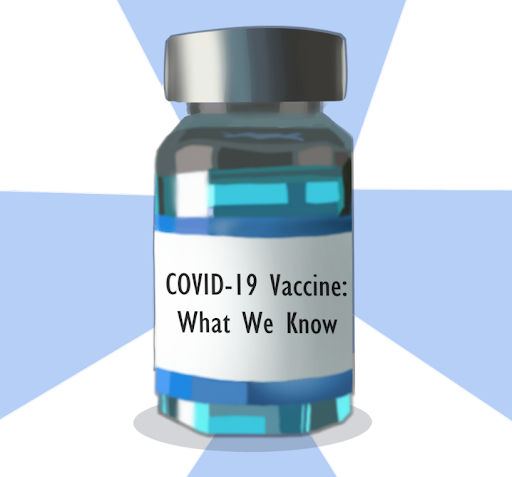COVID-19 Vaccine: What We Know

Graphic Courtesy of Angeline Tan
February 12, 2021
With the start of a new year, many people are determined, even through the pandemic, to accomplish their resolutions with each passing week. While 2020 left many of people suffering at the hands of COVID and its increasing spread rate, the start of 2021 opens up the potential for new opportunities for us to become more informed and educated. What can we do to prevent more infections from happening? The arrival of the new COVID-19 vaccines has made its way to the ears of millions; however, many have but one question lingering on their minds: what is in these new vaccines?
There are two different types of vaccinations that are authorized to be in use: Moderna’s vaccine and Pfizer’s- Bio&Tech vaccine. These vaccines work to provide immunity from the virus while preventing you from getting the disease and granting you protection from the symptoms that others may display. The vaccines work together with your immune system and the cells in your body to strengthen your immunity to the virus, enabling you to produce more antibodies that can combat the illness. Biology major Oneib Qadir of Stony Brook University, who received the Pfizer- Bio&Tech vaccine, explains how the vaccine is essentially, “…prepping the body and preparing for when the real threat tries to wreak havoc.”
As vaccinations become more widespread, many clinical trials have been under the works, revolving around strengthening the vaccine’s effects. According to the Centers for Disease Control and Prevention (CDC), the three main types of COVID vaccines that are underway are mRNA vaccines, protein subunit vaccines and vector vaccines. These three types of vaccines utilize the proteins found within our bodies to help fight the virus, creating new antibodies which can then be used to detect signs of the virus in order to eliminate it. These vaccines do not contain any traces of COVID and show only common side effects such as fevers and fatigue.
The COVID-19 vaccination is currently undergoing emergency distribution to those within healthcare facilities such as healthcare personnel, frontline attendant workers and care facility residents. The target for this decision is to ensure that there are more medical personnel able to properly distribute the vaccine to those who are most vulnerable to the disease. Those who are older than the age of 60 or have underlying medical conditions that have increased risk of obtaining COVID are scheduled to receive the next batch of vaccinations.
When you are scheduled to receive the vaccine, you will be given a medical slip that refers to what type of vaccine you will be receiving as well as when and where you received it. There are two shots that are required for the vaccine. The second shot is recommended even if there are minor side effects from the first shot. After receiving the vaccination, it is recommended that you continue to wear a mask when going out and follow the safety protocols instructed prior to your appointment.
Healthcare worker Verna Lynn Nieva of the Intercommunity Healthcare and Rehabilitation Center details how the vaccine, “…helps you create a defense against the virus but does not fully prevent you from getting the virus,” encouraging the public to take safety protocols even after receiving the vaccine.
Although a new year has begun, the COVID-19 virus has continued its spread from person to person with little signs of slowing down. New protocols are being introduced with each passing day, and I believe that it is our job to understand the virus in order to further prevent the spread from happening. With this new year, there is hope for change, and these changes can come when you least expect them to.
For more information visit:
https://www.cdc.gov/coronavirus/2019-ncov/vaccines/index.html (COVID-19 Vaccine Information)
